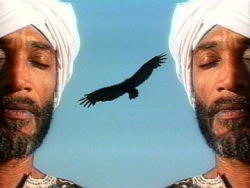Ulysses Jenkins
Overview
Ulysses Jenkins’s video and media work is remarkable for its fusion of forms to conjure vibrant expressions of how image, sound and cultural iconography inform representation. Beginning as a painter and muralist, Jenkins was introduced to video just as the first consumer cameras were made available to individuals, and he quickly seized upon the television technology as a means to broadcast alternative depictions of African and Native American cultures—his own heritage—citing the catalyst of Melvin Van Peebles’s Sweet Sweetback’s Baadasssss Song (1971) and its call to black filmmakers to control their subject-hood by controlling the media depicting them.
